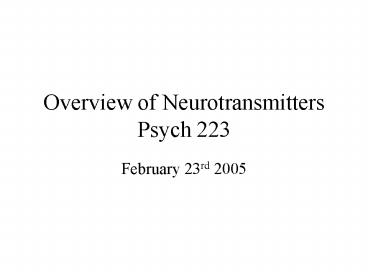Overview of Neurotransmitters Psych 223 PowerPoint PPT Presentation
1 / 19
Title: Overview of Neurotransmitters Psych 223
1
Overview of NeurotransmittersPsych 223
- February 23rd 2005
2
Lecture Outline
- Some myths
- Some facts
- Categories of neurotransmitters
- Acetycholine
- Biogenic amines
- Amino acids
- Peptides
3
Some Myths About Neurotransmitters
- One neuron, one neurotransmitter?
- The classic notion of a neuron held that there
was one transmitter for every neuron. So along
with other aspects of a neuron's phenotype, its
size, shape, location, synaptic connectivity, was
its neuropharmacology. A neuron was designated
as serotonergic, cholinergic etc. However, this
notion has been discarded.
Classic
Revised
4
Some Myths About Neurotransmitters
- One neurotransmitter one receptor?
- Each neurotransmitter system contains several
receptor subtypes. - Each subtype binds the neurotransmitter with high
affinity, but intrinsic activity may vary. - Some subtypes may be predominately presynaptic
while others are postsynaptic. - Subtypes may be linked to different effecter
systems. - Drugs are often selective for one subtype.
5
Some Myths About Neurotransmitters
- One neurotransmitter one receptor?
- Each neurotransmitter system contains several
receptor subtypes. - Each subtype binds the neurotransmitter with high
affinity, but intrinsic activity may vary. - Some subtypes may be predominately presynaptic
while others are postsynaptic. - Subtypes may be linked to different effecter
systems. - Drugs are often selective for one subtype.
6
Some Myths About Neurotransmitters
- One neurotransmitter one receptor?
- Each neurotransmitter system contains several
receptor subtypes. - Each subtype binds the neurotransmitter with high
affinity, but intrinsic activity may vary. - Some subtypes may be predominately presynaptic
while others are postsynaptic. - Subtypes may be linked to different effecter
systems. - Drugs are often selective for one subtype.
7
Some Myths About Neurotransmitters
- One neurotransmitter one receptor?
- Each neurotransmitter system contains several
receptor subtypes. - Each subtype binds the neurotransmitter with high
affinity, but intrinsic activity may vary. - Some subtypes may be predominately presynaptic
while others are postsynaptic. - Subtypes may be linked to different effecter
systems. - Drugs are often selective for one subtype.
Na
Adenylyl cyclase
8
Some Myths About Neurotransmitters
- A digression on Adenylyl Cyclase..
9
Some Myths About Neurotransmitters
- One neurotransmitter one receptor?
- Each neurotransmitter system contains several
receptor subtypes. - Each subtype binds the neurotransmitter with high
affinity, but intrinsic activity may vary. - Some subtypes may be predominately presynaptic
while others are postsynaptic. - Subtypes may be linked to different effecter
systems. - Drugs are often selective for one subtype.
10
Some Myths About Neurotransmitters
- One neurotransmitter one receptor - 5-HT
Subtype Effector 5-HT1A Metabatropic (?
adenylyl cyclase) 5-HT1B 5-HT1D 5-HT1E
5-HT1F 5-HT2A Metabatropic (?
PLC) 5-HT2B 5-HT2C 5-HT3 Ionotropic 5-
HT4 Metabatropic (? adenylyl cyclase) 5-HT5A
Metabatropic (? adenylyl cyclase) 5-HT5B 5-HT
6 Metabatropic (? adenylyl cyclase) 5-HT7
11
Some Myths About Neurotransmitters
- One neurotransmitter one behavior?
- Behaviors are mediated by an extraordinarily
complex circuit of neurons. Even though we will
discuss very complex behaviors in the context of
a single neurotransmitter system. It is not the
case that a single behavior is mediated by one
neurotransmitter and it is not the case that one
neurotransmitter mediates one and only one
behavior.
12
Some Facts About Neurotransmitters
- Localization
- The different types of neurotransmitters are
distributed throughout the brain. However,
certain nuclei are rich in specific
neurotransmitters and are commonly associated
with that neurotransmitter. For example,
serotonin is abundant in the raphe nuclei, and
the raphe provides much of the sertononergic
enervation of the forebrain.
Serotonin pathways in the brain
13
Some Facts About Neurotransmitters
- Localization
Dopamine pathways in the brain
Norepinephrine pathways in the brain
14
Some Facts About Neurotransmitters
- Structure-Function
- There is a structure-function relationship in the
brain where certain structures are critical for
certain behaviors. For example, occipital cortex
is responsible for vision and cerebellum is
responsible for motor coordination. To the
extent that neurotransmitters occur in higher
concentrations in a given area, it would appear
that those neurotransmitters are responsible for
that behavior. At one level neurotransmitters are
responsible for a given behavior, but function is
the result of the connectivity of nuclei not the
neurotransmitter.
15
Some Facts About Neurotransmitters
- Criteria for a neurotransmitter
- Found in the pre-synaptic neuron
- Enzymes for synthesis are found in the
pre-synaptic neuron - There is a mechanism for terminating its action
- Direct application to the post-synaptic neuron
induces the same effect as natural release - When the pre-synaptic neuron is stimulated, the
synapse should contain the transmitter - Drugs that interfere with synthesis should block
the effect of pre-synaptic stimulation - Drugs that interfere with its post-synaptic
effect should block the effect of pre-synaptic
stimulation - Drugs that interfere with metabolism should
prolong the effect of pre-synaptic stimulation
16
Neurotransmitters
- Cholinergics
- Acetycholine
- Choline
- Catacholamines
- Norepeineprine
- Dopamine
- Indoleamines
- Serotonin
- Melatonin
- Amino Acids
- Glutamate
- GABA
- Glycine
- Histamine
- Peptides
- Enkephalins
- b-Endorphin
- Vassopressin
- CRH
- Oxytocin
- VIP
- Somatostatin
- TRH
- ACTH
- (see Table 6.1 in F, M Q)
17
Neurotransmitters
- Cholinergics
- Acetycholine (Ach)
- Movement, arousal, ageing, memory
- Notable parathion, sarin, atropine, nicotine,
curare - Catacholamines
- Norepineprine (NE)
- Mood, arousal, eating, memory
- Notable clonidine, albutorol (ventolin),
propranalol - Dopamine (DA)
- Schizophrenia, drug abuse, motivation, motor
movement - Notable cocaine, haloperidol
- Indoleamines
- Serotonin (5-HT)
- Mood, appetite, aggression, , OCD, sleep
- Notable prozac, LSD, fenfluramine
18
Neurotransmitters
- Amino Acids
- Glutamate
- Ubiquitous learning and memory, cell death
- Notable MSG
- GABA
- Ubiquitous epilepsy, alcohol
- Notable valium
19
Distribution in the Brain
- Acetyocholine 5
- Norepinephrine 2-3
- Dopamine 5
- Serotonin 2-3
- Amino Acids 60
- Peptides 15

